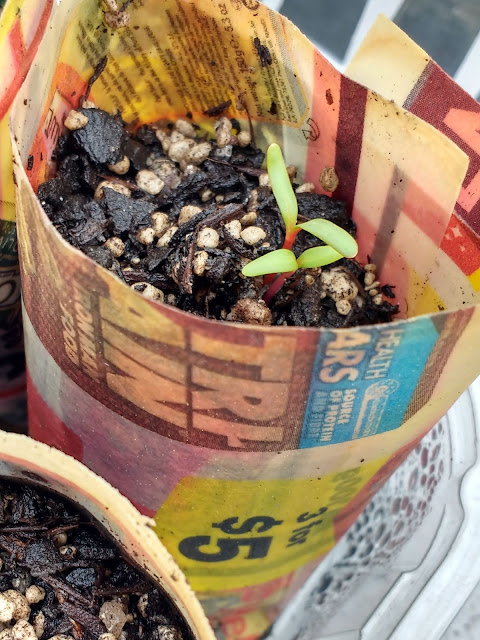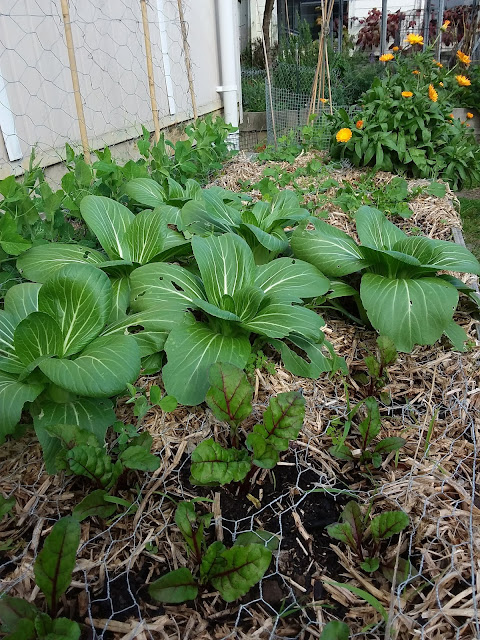Cold Frame Experiments
Remember being a kid lying in the grass, inspecting some tiny flower or bug only inches in front of your nose? I have so many moments like that in my garden. Peering closely for the first signs new growth. Curiosity draws me in, and I find myself temporarily spellbound by every graceful detail of a single leaf. Watching seedlings grow leads to many such moments. After fussing over my first attempt at growing from seed in my new cold frame, I was excited to see these tiny silverbeet sprouts popping up last weekend:
It still somehow takes me by surprise. For ten days it was just a small patch of dirt that I showered with water and hope. And then one day, new life. These are the first seedlings of the season for me, and that is special. Can Spring finally begin now?
While it is technically still Winter for a few more days, it's giving every indication of Spring today. The signature wild winds are blowing, the sun is shinning, and the birds are alternately bickering or courting. The willows by the river near my house suddenly have tiny pale green leaves. And every time I'm out in the garden, I peer closely at the tiny buds on my desciduous trees, closed up so tightly, hiding the promise of Spring.
This new cold frame has given me an excellent opportunity experimentation. Basically a tiny greenhouse, it is an envionment so small that it is easy to control. The main thing I've been concerned with is the fact that it was getting just as cold as the outdoors at night. This is a problem when temperatures below zero are still a possibility. I've both reasearched and brainstormed solutions.
All solutions involve either adding heat or capturing the heat generated during the day. I am ruling out any solution using electronics such as a heating pad. I just want something very simple that I know I will be able to stick with. And from an environmental standpoint I'd like to avoid using electricity to heat anything.
After trying a few types insulating materials over the outside of the cold frame, I was getting discouraged. Anything over the outside of it - blankets, bubble wrap, cardboard, to name a few - you are going to have the elements to contend with. Blankets ideally need to be kept dry, and in our weather anything you stick on there might blow off in the night. Realistically I was going to need to throw a tarp over the whole thing and weight or tie it down really well. Things were getting complicated.
Then I thought of trying something put over the plants inside the cold frame. The only thing I had on hand that made sense was bubble wrap. Bubble wrap is basically a bunch of tiny cells of trapped air, so it has pretty good insulating properties. It also has the advantage of being very light. It's not such a worry now, but when the seedlings start to grow taller, I'll need to place something on them that won't smush them down. I've tried this for a week now, and it's working as well or better than previous experiments. When I go to remove it in the morning, the temperature under the bubble wrap has been three to four degrees hotter than the temperature outdoors.
Another thing you can do is add heat-absorbant material inside the cold frame. Something that will heat up during the day and hold onto that heat, slowly releasing it through the night. Good options are water and stone. I have added a few water-filled milk jugs; I'lll keep adding more as we keep drinking milk. Painting them black helps them absorb heat, but I haven't gotten around to trying this yet. While random stones seem a kind of messy option, I have a stack of old bricks that I may lay down on the floor of the green house or place around the edges for a similar effect. So far my milk jugs are placed right around the edges of my seedling trays.
I still worry about my new little seedlings if we get another frost. An easy solution would be to just bring them indoors over night. Another option is to take those milk jugs and fill them with hot water from the tap (not boiling water - it can damage the plastic). I may try this, as I do like the idea of essentially placing hot water bottles next to my plants, and tucking them into their bubble wrap blankets for the night.




Comments
Post a Comment